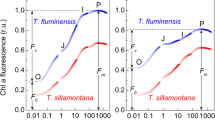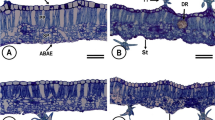Abstract
Leaf reddening in overwintering evergreens largely restricts their application in landscapes and is generally triggered in response to excess light. To explore how leaves respond to excess light and examine the potential relevance of leaf reddening in this process, a comparative field study was conducted on the sun leaves (SUL), shade leaves (SHL) and three levels of artificially shaded sun leaves (SSUL) of Buxus microphylla ‘Wintergreen’. The seasonal changes in leaf colorations, chlorophyll (Chl) and carotenoid contents, leaf absorbance and chlorophyll fluorescence characteristics were investigated. The results showed that SUL upregulated Chl a/b with increased reductions in Chl b compared with Chl a, accumulated red pigments in the upper palisade mesophyll with reduced absorption in blue and red light but increased absorption in green light, and additionally, significantly downregulated photochemical activities through the sustained enhancement of energy dissipation in PSII antenna (ΦD) from fall to midwinter. In the SSUL, as the light intensity decreased, all of the above processes were mitigated except that the SSUL maintained constant absorptions in blue light region and whose levels were similar to those of the SUL and SHL. In contrast, the SHL maintained relatively high levels of Chl a and Chl b, remained completely green and showed regulated ΦD and ΦE (energy dissipation in PSII reaction centers) to maintain relatively high photochemical activity in the winter. We conclude that the sun leaves downregulate Chl contents to reduce the light absorption and simultaneously enhance sustained ΦD to dissipate most of the light energy, whereas shade leaves maintain relatively high Chl contents and demonstrate regulated proportions of ΦD and ΦE to match the extent to which the absorbed light can be utilized through photochemical reactions. The accumulated red pigments in sun phenotypes may provide a shading effect on Chls by directing energy to non-photosynthetic reaction centers in the blue light region where the absorption is offset by the reduced Chls.







Similar content being viewed by others
References
Adams WW, Demmig-Adams B (2014) Lessons from nature: A personal perspective. In: Demmig-Adams B, Garab G, Adams WW, Govindjee (eds) Non-photochemical quenching and energy dissipation in plants, algae and cyanobacteria. Advances in photosynthesis and respiration, vol. 40. Springer, Dordrecht, Netherlands. pp 45–72
Adams WW, Demmig-Adams B, Barker D, Kiley S (1996) Carotenoids and photosystem II characteristics of upper and lower halves of leaves acclimated to high light. Aust J Plant Physiol 23:669–677
Adams WW, Demmig-Adams B, Rosenstiel TN, Brightwell AK, Ebbert V (2002) Photosynthesis and photoprotection in overwintering plants. Plant Biol 4:545–557
Adams WW, Zarter CR, Ebbert V, Demmig-Adams B (2004) Photoprotective strategies of overwintering evergreens. Bioscience 54:41–49
Barker DH, Adams WW (1997) The xanthophyll cycle and energy dissipation in differently oriented faces of the cactus opuntia macrorhiza. Oecologia 109:353–361
Bernini D, Caucia F, Boiocchi M (2009) Application of the Vis-NIR Avaspec-2048 portable automatic spectrometer to distinguish GEM quality materials. Neues Jb Miner Abh 185:281–288
Bouvier F, Backhaus RA, Camara B (1998) Induction and control of chromoplast-specific carotenoid genes by oxidative stress. J Biol Chem 273:30651–30659
Cohu CM, Muller O, Adams WW, Demmig-Adams B (2014) Leaf anatomical and photosynthetic acclimation to cool temperature and high light in two winter versus two summer annuals. Physiol Plant 152:164–173
Contreras RN, Ruter JM, Owen JS Jr, Hoegh A (2013) Chlorophyll, carotenoid, and visual color rating of Japanese-cedar grown in the Southeastern United States. HortScience 48:1452–1456
Demmig-Adams B, Adams WW (2006) Photoprotection in an ecological context: The remarkable complexity of thermal energy dissipation. New Phytol 172:11–21
Demmig-Adams B, Adams WW, Barker DH, Logan BA, Bowling DR, Verhoeven AS (1996) Using chlorophyll fluorescence to assess the fraction of absorbed light allocated to thermal dissipation of excess excitation. Physiol Plant 98:253–264
Di Domenico F, Lucchese F, Magri D (2012) Buxus in Europe: late quaternary dynamics and modern vulnerability, Perspect. Plant Ecol Evol Syst 14:354–362
Duc AL, Parsons LR, Pair JC (2000) Growth, survival, and aesthetic quality of boxwood cultivars as affected by landscape exposure. Hort Sci 35:205–208
Endo T, Uebayashi N, Ishida S, Ikeuchi M, Sato F (2014) Light energy allocation at PSII under field light conditions: How much energy is lost in NPQ-associated dissipation? Plant Physiol Biochem 81:115–120
García-Plazaola JI, Esteban R, Hormaetxe K, Becerril J (2008) Seasonal reversibility of acclimation to irradiance in leaves of common box (Buxus sempervirens L.) in a deciduous forest. Flora Morphol Distrib Funct Ecol Plants 203:254–260
Han Q, Shinohara K, Kakubari Y, Mukai Y (2003) Photoprotective role of rhodoxanthin during cold acclimation in cryptomeria japonica. Plant Cell Environ 26:715–723
Han Q, Katahata S, Kakubari Y, Mukai Y (2004) Seasonal changes in the xanthophyll cycle and antioxidants in sun-exposed and shaded parts of the crown of cryptomeria japonica in relation to rhodoxanthin accumulation during cold acclimation. Tree Physiol 24:609–616
Hong S, Xu D (1999) Light-induced increase in initial chlorophyll fluorescence Fo level and the reversible inactivation of PS II reaction centers in soybean leaves. Photosynth Res 61:269–280
Hormaetxe K, Hernández A, Becerril JM, García-Plazaola JI (2004) Role of red carotenoids in photoprotection during winter acclimation in Buxus sempervirens leaves. Plant Biol 6:325–332
Hormaetxe K, Becerril JM, Fleck I, Pintó M, García-Plazaola JI (2005) Functional role of red (retro)-carotenoids as passive light filters in the leaves of Buxus sempervirens L.: increased protection of photosynthetic tissues? J Exp Bot 56:2629–2636
Hormaetxe K, Becerril JM, Hernández A, Esteban R, García-Plazaola JI (2007) Plasticity of photoprotective mechanisms of Buxus sempervirens L. leaves in response to extreme temperatures. Plant Biol 9:59–68
Hughes NM (2011) Winter leaf reddening in ‘evergreen’ species. New Phytol 190:573–581
Hughes NM, Neufeld HS, Burkey KO (2005) Functional role of anthocyanins in high-light winter leaves of the evergreen herb galax urceolata. New Phytol 168:575–587
Hughes NM, Burkey KO, Cavender-Bares J, Smith WK (2012) Xanthophyll cycle pigment and antioxidant profiles of winter-red (anthocyanic) and winter-green (acyanic) angiosperm evergreen species. J Exp Bot 63:1895–1905
Huner NPA, Öquist G, Sarhan F (1998) Energy balance and acclimation to light and cold. Trends Plant Sci 3:224–230
Ida K, Masamoto K, Maoka T, Fujiwara Y, Takeda S, Hasegawa E (1995) The leaves of the common box, Buxus sempervirens (Buxaceae), become red as the level of a red carotenoid, anhydroeschscholtzxanthin, increases. J Plant Res 108:369–376
Jiang XR, Peng JG, Guo L, Gao RF, Liu Y (2015) Relationship between winter leaf reddening and carotenoids, reactive oxygen species in Buxus microphylla L. J Beijing Forest Univ 37:93–99
Koiwa H, Ikeda T, Yoshida Y (1986) Reversal of chromoplasts to chloroplasts in Buxus leaves. Bot Magaz Shokubutsu-gaku-zasshi 99:233–240
Latowski D, Grzyb J, Strzalka K (2004) The xanthophyll cycle—molecular mechanism and physiological significance. Acta Physiol Plant 26:197–212
Lichtenthaler HK, Wellburn AR (1983) Determinations of total carotenoids and chlorophylls a and b of leaf extracts in different solvents. Biochm Soc Trans 11:591–592
Lichtenthaler HK, Buschmann C, Knapp M (2005) How to correctly determine the different chlorophyll fluorescence parameters and the chlorophyll fluorescence decrease ratio RFd of leaves with the PAM fluorometer. Photosynthetica 43:379–393
Logan BA, Demmig-Adams B, Adams WW, Bilger W (2014) Context, quantification, and measurement guide for non-photochemical quenching of chlorophyll fluorescence, In: Demmig-Adams B, Garab G, Adams WW`, Govindjee (eds) Non-photochemical quenching and energy dissipation in plants, algae and cyanobacteria. Advances in photosynthesis and respiration, vol. 40. Springer, Dordrecht, Netherlands. pp 187–201
Merzlyak M, Solovchenko A, Pogosyan S (2005) Optical properties of rhodoxanthin accumulated in aloe arborescens Mill. leaves under high-light stress with special reference to its photoprotective function. Photochem Photobiol Sci 4:333–340
Nishio JN (2000) Why are higher plants green? Evolution of the higher plant photosynthetic pigment complement. Plant Cell Environ 23:539–548
Öquist G, Huner NP (2003) Photosynthesis of overwintering evergreen plants. Annu Rev Plant Biol 54:329–355
Peng JG, Liu Y, Guo L, Gao RF (2011) Color change and chlorophyll fluorescence kinetics characteristics of Buxus microphylla leaves during the period of overwintering and regreening. J Beijing Forestry Univ 33:27–34
Petrov KA, Sofronova VE, Chepalov VA, Perk AA, Maksimov TK (2010) Seasonal changes in the content of photosynthetic pigments in perennial grasses of cryolithic zone. Russ J Plant Physiol 57:181–188
Rüdiger W (2002) Biosynthesis of chlorophyll b and the chlorophyll cycle. Photosynth Res 74:187–193
Schindelin J, Arganda-Carreras I, Frise E, Kaynig V, Longair M, Pietzsch T, Preibisch S, Rueden C, Saalfeld S, Schmid B, Tinevez JY, White DJ, Hartenstein V, Eliceiri K, Tomancak P, Cardona A (2012) Fiji: an open-source platform for biological-image analysis. Nat Methods 9:676–682
Siebke K, Ball MC (2009) Non-destructive measurement of chlorophyll b: a ratios and identification of photosynthetic pathways in grasses by reflectance spectroscopy. Funct Plant Biol 36:857–866
Silva-Cancino MC, Esteban R, Artetxe U, García-Plazaola JI (2012) Patterns of spatio-temporal distribution of winter chronic photoinhibition in leaves of three evergreen Mediterranean species with contrasting acclimation responses. Physiol Plant 144:289–301
Tanaka R, Tanaka A (2011) Chlorophyll cycle regulates the construction and destruction of the light-harvesting complexes. Biochim Biophys Acta 1807:968–976
Vanderauwera S, Zimmermann P, Rombauts S, Vandenabeele S, Langebartels C, Gruissem W, Inzé D, Van Breusegem F (2005) Genome-wide analysis of hydrogen peroxide-regulated gene expression in Arabidopsis reveals a high light-induced transcriptional cluster involved in anthocyanin biosynthesis. Plant Physiol 139:806–821
Verhoeven A (2014) Sustained energy dissipation in winter evergreens. New Phytol 201:57–65
Verhoeven AS, Adams WW, Demmig-Adams B (1998) Two forms of sustained xanthophyll cycle-dependent energy dissipation in overwintering euonymus kiautschovicus. Plant Cell Environ 21:893–903
Warren C (2006) Estimating the internal conductance to CO2 movement. Funct Plant Biol 33:431–442
Weger HG, Silim SN, Guy RD (1993) Photosynthetic acclimation to low temperature by western red cedar seedlings. Plant Cell Environ 16:711–717
Acknowledgments
This work was supported by the Beijing Municipal Science and Technology Commission (Z08050602970801).
Author information
Authors and Affiliations
Corresponding author
Additional information
Communicated by K. Apostol.
Electronic supplementary material
Below is the link to the electronic supplementary material.
11738_2016_2274_MOESM1_ESM.docx
Fig. S1 Leaf colorations of B. microphylla ‘Wintergreen’ for the SUL, SSUL and SHL during the overwintering period (2012–2013). Fig. S2 Typical winter noon solar irradiance pattern of ambient light for the SUL, SSUL and SHL. The normalized spectra in the wavelength region (max = 1) are shown in the top right. The data were obtained from Jan. 25, 2015. All results are presented as the mean values of five replicates. Fig. S3 Spectra of the light source provided from a tungsten lamp in the leaf spectroscopic measurements. Fig. S4 The anthocyanin contents of the red sun and green shade leaves of Buxus microphylla ‘Wintergreen’ and Euonymus kiautschovicus (a winter red species reflecting the accumulation of anthocyanins) in the winter. The leaves were sampled on Jan. 5, 2012 and the anthocyanins were extracted in 2 ml of 1 % HCl in methanol and quantified spectrophotometrically as A530–0.24A653 (Murray and Hackett 1991, Plant Physiol 97: 343–351) using a Biomate 3S UV–Visible Spectrophotometer (Thermo Fisher Scientific, Waltham, MA, USA) on the same day. The bars represent the mean ± SD (n = 3). Fig. S5 The contents of Chl a and Chl b of Buxus microphylla ‘Wintergreen’ for the SUL, SSUL and SHL between fall (Oct. 20, 2014) and midwinter (Jan. 23, 2015). The extraction method was the same as that used in overwintering leaves during the period of 2012–2013 except that the contents of Chls were quantified on leaf area basis. Different lowercase letters indicate statistically significant differences (P ≤ 0.05) using Tukey’s HSD tests. The bars represent the mean ± SD (n = 3) (DOCX 1239 kb)
Rights and permissions
About this article
Cite this article
Peng, J., Jiang, X., Jia, M. et al. Contrasting patterns of sun-red and shade-green leaves of Buxus microphylla in response to gradients of excess light during winter acclimation. Acta Physiol Plant 38, 254 (2016). https://doi.org/10.1007/s11738-016-2274-8
Received:
Revised:
Accepted:
Published:
DOI: https://doi.org/10.1007/s11738-016-2274-8




